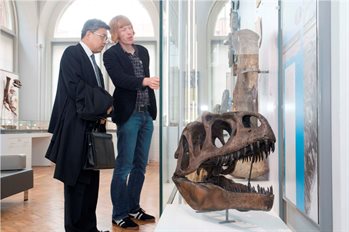
The Lapworth Museum of Geology was delighted to give Professor Gong Ke, President of Nankai University, and the University of Birmingham China Institute a personal tour of the completely new Lapworth Museum of Geology.
Our Chinese visitors were impressed by many parts of the displays, but particularly our new skeleton of the dinosaur Allosaurus, our unique floor-to-ceiling ‘rock wall’ and the marvellous display of fluorescent minerals.
The University of Birmingham has a long tradition of engagement with China in the area of geology and Earth science. An early student at the University was Li Siguang, one of the best-known scientists in China, who as a geologist was behind the discovery of much of China’s oil and gas reserves, made major advances in understanding the geological history of China, and was a pioneer in predicting earthquakes. Li Siguang arrived in Birmingham in 1914 to study in the School of Mining, receiving his BSc in 1917 and his MSc in 1918. He later returned to the University for his doctorate, awarded in 1931. Li Siguang went on to become an academician and Vice-President of the Chinese Academy of Sciences, along with other prestigious positions such as Minister for Geology. The Lapworth Museum holds archival material relating to Li Siguang’s time in Birmingham, including the external examiner’s report on his 1918 MSc thesis, and a photograph of him together with other Birmingham geologists on a fieldtrip in Wales in 1935.
Today, engagement with China continues, primarily through collaborations between palaeontologists based within Earth Sciences and the Lapworth Museum at Birmingham and a number of different institutions in China. These collaborations include work on fossils of primitive fish from the Silurian (445–420 million years ago), the evolution of plant communities during the Permian (300–250 million years ago), and the origin and rise of dinosaurs and their relatives during the Triassic (250–200 million years ago) and following time periods. These collaborations make use of the unique Chinese fossil record and the exceptional expertise that Chinese scientists have in this subject area.